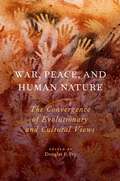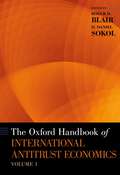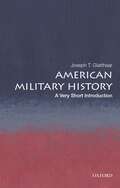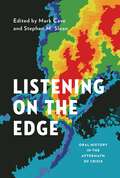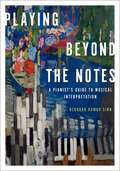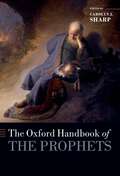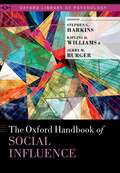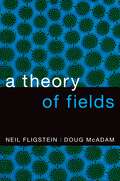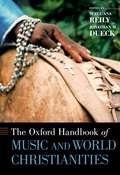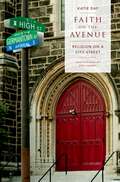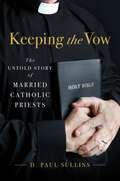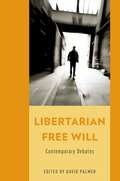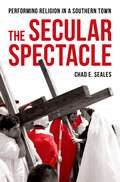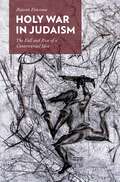- Table View
- List View
The American West: A Very Short Introduction (Very Short Introductions)
by Stephen AronPart geographical location, part time period, and part state of mind, the American West is a concept often invoked but rarely defined. Though popular culture has carved out a short and specific time and place for the region, author and longtime Californian Stephen Aron tracks "the West" from the building of the Cahokia Mounds around 900 AD to the post-World War II migration to California. His Very Short Introduction stretches the chronology, enlarges the geography, and varies the casting, providing a history of the American West that is longer, larger, and more complicated than popular culture has previously suggested. It is a history of how portions of North America became Wests, how parts of these became American, and how ultimately American Wests became the American West. Aron begins by describing the expansion of Indian North America in the centuries before and during its early encounters with Europeans. He then explores the origins of American westward expansion from the Seven Years' War to the 1830s, focusing on the western frontier at the time: the territory between the Appalachian Mountains and the Mississippi River. He traces the narrative - temporally and geographically - through the discovery of gold in California in the mid-nineteenth century and the subsequent rush to the Pacific Slope. He shows how the passage of the Newlands Reclamation Act in 1902 brought an unprecedented level of federal control to the region, linking the West more closely to the rest of the United States, and how World War II brought a new rush of population (particularly to California), further raising the federal government's profile in the region and heightening the connections between the West and the wider world. Authoritative, lucid, and ranging widely over issues of environment, people, and identity, this is the American West stripped of its myths. The complex convergence of peoples, polities, and cultures that has decisively shaped the history of the American West serves as the key interpretive thread through this Very Short Introduction. ABOUT THE SERIES: The Very Short Introductions series from Oxford University Press contains hundreds of titles in almost every subject area. These pocket-sized books are the perfect way to get ahead in a new subject quickly. Our expert authors combine facts, analysis, perspective, new ideas, and enthusiasm to make interesting and challenging topics highly readable.
War, Peace, and Human Nature: The Convergence of Evolutionary and Cultural Views
by Douglas P. FryHave humans always waged war? Is warring an ancient evolutionary adaptation or a relatively recent behavior--and what does that tell us about human nature? In War, Peace, and Human Nature, editor Douglas P. Fry brings together leading experts in such fields as evolutionary biology, archaeology, anthropology, and primatology to answer fundamental questions about peace, conflict, and human nature in an evolutionary context. The chapters in this book demonstrate that humans clearly have the capacity to make war, but since war is absent in some cultures, it cannot be viewed as a human universal. And counter to frequent presumption the actual archaeological record reveals the recent emergence of war. It does not typify the ancestral type of human society, the nomadic forager band, and contrary to widespread assumptions, there is little support for the idea that war is ancient or an evolved adaptation. Views of human nature as inherently warlike stem not from the facts but from cultural views embedded in Western thinking. Drawing upon evolutionary and ecological models; the archaeological record of the origins of war; nomadic forager societies past and present; the value and limitations of primate analogies; and the evolution of agonism, including restraint; the chapters in this interdisciplinary volume refute many popular generalizations and effectively bring scientific objectivity to the culturally and historically controversial subjects of war, peace, and human nature.
The Oxford Handbook of Ethnicity, Crime, and Immigration (Oxford Handbooks)
by Sandra M. Bucerius Michael TonrySocial tensions between majority and minority populations often center on claims that minorities are largely responsible for crime and disorder. Members of some disadvantaged groups in all developed countries, sometimes long-standing residents and other times recent immigrants, experience unwarranted disparities in their dealings with the criminal justice system. Accusations of unfair treatment by police and courts are common. The Oxford Handbook of Ethnicity, Crime, and Immigration provides comprehensive analyses of current knowledge about these and a host of related subjects. Topics include legal and illegal immigration, ethnic and race relations, and discrimination and exclusion, and their links to crime in the United States and elsewhere. Leading scholars from sociology, criminology, law, psychology, geography, and political science document and explore relations among race, ethnicity, immigration, and crime. Individual chapters provide in-depth critical overviews of key issues, controversies, and research. Contributors present the historical backdrops of their subjects, describe population characteristics, and summarize relevant data and research findings. Most articles provide synopses of racial, ethnic, immigration, and justice-related concerns and offer policy recommendations and proposals for future research. Some articles are case studies of particular problems in particular places, including juvenile incarceration, homicide, urban violence, social exclusion, and other issues disproportionately affecting disadvantaged minority groups. The Oxford Handbook of Ethnicity, Crime, and Immigration is the first major effort to examine and synthesize knowledge concerning immigration and crime, ethnicity and crime, and race and crime in one volume, and does so both for the United States and for many other countries.
The Oxford Handbook of International Antitrust Economics, Volume 1 (Oxford Handbooks)
More than any other area of regulation, antitrust economics shapes law and policy in the United States, the Americas, Europe, and Asia. In a number of different areas of antitrust, advances in theory and empirical work have caused a fundamental reevaluation and shift of some of the assumptions behind antitrust policy. This reevaluation has profound implications for the future of the field. The Oxford Handbook of International Antitrust Economics has collected chapters from many of the leading figures in antitrust. In doing so, this two volume Handbook provides an important reference guide for scholars, teachers, and practitioners. However, it is more than a merely reference guide. Rather, it has a number of different goals. First, it takes stock of the current state of scholarship across a number of different antitrust topics. In doing so, it relies primarily upon the economics scholarship. In some situations, though, there is also coverage of legal scholarship, case law developments, and legal policies. The second goal of the Handbook is to provide some ideas about future directions of antitrust scholarship and policy. Antitrust economics has evolved over the last 60 years. It has both shaped policy and been shaped by policy. The Oxford Handbook of International Antitrust Economics will serve as a policy and research guide of next steps to consider when shaping the future of the field of antitrust.
American Military History: A Very Short Introduction (Very Short Introductions)
by Joseph T. GlatthaarSince the first English settlers landed at Jamestown with the legacy of centuries of European warfare in tow, the military has been an omnipresent part of America. In American Military History: A Very Short Introduction, Joseph T. Glatthaar explores this relationship from its origins in the thirteen colonies to today's ongoing conflicts in the Middle East. During the Revolutionary War, tension grew between local militias and a standing army. The Founding Fathers attempted to strike a balance, enshrining an army, navy, and a "well-regulated Militia" in the Constitution. The US soon witnessed the rise of a professional military, a boon to its successes in the War of 1812, the Mexican War, and the Civil War. However, after the Civil War, the US struggled to learn that the purpose of a peacetime army is to prepare for war. When war did arrive, it arrived with a vengeance, gutting the trenches of the Great War with effective innovations: tanks, planes, machine guns, and poison gas. The US embraced the technology that would win both world wars and change the nature of battle in the Second World War. The US emerged from World War II as the most powerful nation in the war, but over the next several decades it was forced to confront the limits of its power. The nuclear era brought encounters defined by stalemate--from the Cold War conflicts of Korea and Vietnam to the wars in Afghanistan and Iraq. Since 9/11, the US has been frustrated by unconventional warfare, including terrorism and cyberwar, largely negating the technological advantage it had held. Glatthaar examines all these challenges, looking to the future of the U.S. military and its often proud and complicated legacy.
American Military History: A Very Short Introduction (Very Short Introductions)
by Joseph T. GlatthaarSince the first English settlers landed at Jamestown with the legacy of centuries of European warfare in tow, the military has been an omnipresent part of America. In American Military History: A Very Short Introduction, Joseph T. Glatthaar explores this relationship from its origins in the thirteen colonies to today's ongoing conflicts in the Middle East. During the Revolutionary War, tension grew between local militias and a standing army. The Founding Fathers attempted to strike a balance, enshrining an army, navy, and a "well-regulated Militia" in the Constitution. The US soon witnessed the rise of a professional military, a boon to its successes in the War of 1812, the Mexican War, and the Civil War. However, after the Civil War, the US struggled to learn that the purpose of a peacetime army is to prepare for war. When war did arrive, it arrived with a vengeance, gutting the trenches of the Great War with effective innovations: tanks, planes, machine guns, and poison gas. The US embraced the technology that would win both world wars and change the nature of battle in the Second World War. The US emerged from World War II as the most powerful nation in the war, but over the next several decades it was forced to confront the limits of its power. The nuclear era brought encounters defined by stalemate--from the Cold War conflicts of Korea and Vietnam to the wars in Afghanistan and Iraq. Since 9/11, the US has been frustrated by unconventional warfare, including terrorism and cyberwar, largely negating the technological advantage it had held. Glatthaar examines all these challenges, looking to the future of the U.S. military and its often proud and complicated legacy.
Listening on the Edge: Oral History in the Aftermath of Crisis (Oxford Oral History Series)
by Mark Cave Stephen M. SloanFrom the headlines of local newspapers to the coverage of major media outlets, scenes of war, natural disaster, political revolution and ethnic repression greet readers and viewers at every turn. What we often fail to grasp, however, despite numerous treatments of events is the deep meaning and broader significance of crisis and disaster. The complexity and texture of these situations are most evident in the broader personal stories of those whom the events impact most intimately. Oral history, with its focus on listening and collaborative creation with participants, has emerged as a forceful approach to exploring the human experience of crisis. Despite the recent growth of crisis oral history fieldwork, there has been little formal discussion of the process and meaning of utilizing oral history in these environments. Oral history research takes on special dimensions when working in highly charged situations often in close proximity to traumatic events. The emergent inclination for oral historians to respond to document crisis calls for a shared conversation among scholars as to what we have learned from crisis work so far. This dialogue, at the heart of this collection of oral history excerpts and essays, reveals new layers of the work of the oral historian. From the perspective of crisis and disaster oral history, the book addresses both the ways in which we think about the craft of oral hsitory, and the manner in which we use it. The book presents excerpts from oral histories done after twelve world crises, followed by critical analyses by the interviewers. Additional analytical chapters set the interviews in the contexts of pyschoanalysis and oral history methodology.
A Twenty-First Century US Water Policy
by Juliet Christian-Smith Peter H. Gleick Heather Cooley Lucy Allen Amy Vanderwarker Kate A. BerryIt is zero hour for a new US water policy! At a time when many countries are adopting new national approaches to water management, the United States still has no cohesive federal policy, and water-related authorities are dispersed across more than 30 agencies. Here, at last, is a vision for what we as a nation need to do to manage our most vital resource. In this book, leading thinkers at world-class water research institution the Pacific Institute present clear and readable analysis and recommendations for a new federal water policy to confront our national and global challenges at a critical time. What exactly is at stake? In the 21st century, pressures on water resources in the United States are growing and conflicts among water users are worsening. Communities continue to struggle to meet water quality standards and to ensure that safe drinking water is available for all. And new challenges are arising as climate change and extreme events worsen, new water quality threats materialize, and financial constraints grow. Yet the United States has not stepped up with adequate leadership to address these problems. The inability of national policymakers to safeguard our water makes the United States increasingly vulnerable to serious disruptions of something most of us take for granted: affordable, reliable, and safe water. This book provides an independent assessment of water issues and water management in the United States, addressing emerging and persistent water challenges from the perspectives of science, public policy, environmental justice, economics, and law. With fascinating case studies and first-person accounts of what helps and hinders good water management, this is a clear-eyed look at what we need for a 21st century U.S. water policy.
Playing Beyond the Notes: A Pianist's Guide to Musical Interpretation
by Deborah Rambo SinnPlaying Beyond the Notes: A Pianist's Guide to Musical Interpretation demystifies the complex concepts of musical interpretation in Western tonal piano music by boiling it down to basic principles in an accessible writing style. Author and veteran piano instructor Deborah Rambo Sinn tackles a different interpretive principle, explaining clearly, for example, how to play effective ornaments and rubatos. As a whole, the book helps pianists understand concrete ways to apply interpretive concepts to their own playing and gives teachers practical ways to teach interpretation to their students. The book is illustrated with over 200 repertoire excerpts and supplemented by a companion website with over 100 audio recordings. Playing Beyond the Notes is essential reading for all performing pianists, independent piano teachers, and piano pedagogy students.
The City: A World History (New Oxford World History)
by Andrew LeesThe City: A World History tells the story of the rise and development of urban centers from ancient times to the twenty-first century. It begins with the establishment of the first cities in the Near East in the fourth millennium BCE, and goes on to examine urban growth in the Indus River Valley in India, as well as Egypt and areas that bordered the Mediterranean Sea. Athens, Alexandria, and Rome stand out both politically and culturally. With the fall of the Roman Empire in the West, European cities entered into a long period of waning and deterioration. But elsewhere, great cities-among them, Constantinople, Baghdad, Chang'an, and Tenochtitlán-thrived. In the late Middle Ages and the Early Modern period, urban growth resumed in Europe, giving rise to cities like Florence, Paris, and London. This urban growth also accelerated in parts of the world that came under European control, such as Philadelphia in the nascent United States. As the Industrial Revolution swept through in the nineteenth century, cities grew rapidly. Their expansion resulted in a slew of social problems and political disruptions, but it was accompanied by impressive measures designed to improve urban life. Meanwhile, colonial cities bore the imprint of European imperialism. Finally, the book turns to the years since 1914, guided by a few themes: the impact of war and revolution; urban reconstruction after 1945; migration out of many cities in the United States into growing suburbs; and the explosive growth of "megacities" in the developing world.
The Oxford Handbook of the Prophets (Oxford Handbooks)
by Carolyn J. SharpThe Latter Prophets--Isaiah, Jeremiah, Ezekiel, and the Book of the Twelve--comprise a fascinating collection of prophetic oracles, narratives, and vision reports from ancient Israel and Judah. Spanning centuries and showing evidence of compositional growth and editorial elaboration over time, these prophetic books offer an unparalleled view into the cultural norms, theological convictions, and political disputes of Israelite communities caught in the maelstrom of militarized conflicts with the empires of ancient Egypt, Babylonia, and Persia. Instructive for scholar and student alike, The Oxford Handbook of the Prophets features wide-ranging discussion of ancient Near Eastern social and cultic contexts; exploration of focused topics such as the persona of the prophet and the problem of violence in prophetic rhetoric; sophisticated historical and literary analysis of key prophetic texts; issues in reception history, from these texts' earliest reinterpretations at Qumran to Christian appropriations in contemporary homiletics; feminist, materialist, and postcolonial readings engaging the insights of influential contemporary theorists; and more. The diversity of interpretive approaches, clarity of presentation, and breadth of expertise represented here will make this Handbook indispensable for research and teaching on the Latter Prophets.
Why Capitalism?
by Allan H. MeltzerA review of the headlines of the past decade seems to show that disasters are often part of capitalist systems: the high-tech bubble, the Enron fraud, the Madoff Ponzi scheme, the great housing bubble, massive lay-offs, and a widening income gap. Disenchantment with the market economy has reached the point that many even question capitalism itself. Allan H. Meltzer disagrees, passionately and persuasively. Drawing on deep expertise as a financial historian and authority on economic theory, he provides a resounding answer to the question, "why capitalism?" Only capitalism, he writes, maximizes both growth and individual freedom. Unlike socialism, capitalism is adaptive, not rigid--private ownership of the means of production flourishes wherever it takes root, regardless of culture. Laws intended to tamper with its fundamental dynamics, such as those that redistribute wealth, fail. European countries boasting extensive welfare programs have not surpassed the more market-oriented United States. Capitalism does require a strong legal framework, Meltzer writes, and it does not solve all problems efficiently. But he finds that its problems stem from universal human weaknesses--such as dishonesty, venality, and expediency--which are not specific to capitalism. Along the way, he systematically analyzes the role of government, positing that regulations are static, but markets are dynamic, usually seeking ways to skirt the rules. Regulation is socially useful if it brings private costs into line with social costs (for example, the cost of taxes to hire policemen compared to that of the impact of rampant crime); if it doesn't, regulation simply invites circumvention. Vigorously argued, sweeping in scope, Why Capitalism? reminds us of the fundamental vitality of the one economic system that has survived every challenge, and risen to dominate the globe.
The Oxford Handbook of Social Influence (Oxford Library of Psychology)
The study of social influence has been central to social psychology since its inception. In fact, research on social influence predated the coining of the term social psychology. Its influence continued through the 1960s, when it made seminal contributions to the beginning of social psychology's golden age. However, by the mid-1980s, interest in this area waned, while at the same time, and perhaps not coincidentally, interest in social cognition waxed. Now the pendulum is swinging back, as seen in growing interest in non-cognitive, motivational accounts. The Oxford Handbook of Social Influence will contribute to a resurgence of interest in social influence that will restore it to its once preeminent position. Written by leading scholars, the chapters cover a variety of topics related to social influence, incorporating a range of levels of analysis (intrapersonal, interpersonal, and intragroup) and both source (the influencers) and target (the influenced) effects. The volume also examines theories that are most relevant to social infl uence, as well as social influence in applied settings. The chapters contribute to the renaissance of interest in social influence by showing that it is time to reexamine classic topics in social influence; by illustrating how integrations/ elaborations that advance our understanding of social influence processes are now possible; by revealing gaps in the social influence literature; and by suggesting future lines of research. Perhaps the most important of these lines of work will take into account the change from traditional social influence that occurs face-to-face to social media-mediated influence that is likely to characterize many of our interactions in the future.
A Theory of Fields
by Neil Fligstein Doug McAdamFinding ways to understand the nature of social change and social order-from political movements to market meltdowns-is one of the enduring problems of social science. A Theory of Fields draws together far-ranging insights from social movement theory, organizational theory, and economic and political sociology to construct a general theory of social organization and strategic action. In a work of remarkable synthesis, imagination, and analysis, Neil Fligstein and Doug McAdam propose that social change and social order can be understood through what they call strategic action fields. They posit that these fields are the general building blocks of political and economic life, civil society, and the state, and the fundamental form of order in our world today. Similar to Russian dolls, they are nested and connected in a broader environment of almost countless proximate and overlapping fields. Fields are mutually dependent; change in one often triggers change in another. At the core of the theory is an account of how social actors fashion and maintain order in a given field. This sociological theory of action, what they call "social skill," helps explain what individuals do in strategic action fields to gain cooperation or engage in competition. To demonstrate the breadth of the theory, Fligstein and McAdam make its abstract principles concrete through extended case studies of the Civil Rights Movement and the rise and fall of the market for mortgages in the U.S. since the 1960s. The book also provides a "how-to" guide to help others implement the approach and discusses methodological issues. With a bold new approach, A Theory of Fields offers both a rigorous and practically applicable way of thinking through and making sense of social order and change-and how one emerges from the other-in modern, complex societies.
The Oxford Handbook of Music and World Christianities (Oxford Handbooks)
The Oxford Handbook of Music and World Christianities investigates music's role in everyday practice and social history across the diversity of Christian religions and practices around the globe. The volume explores Christian communities in the Americas, Europe, Africa, Asia, and Australia as sites of transmission, transformation, and creation of deeply diverse musical traditions. The book's contributors, while mostly rooted in ethnomusicology, examine Christianities and their musics in methodologically diverse ways, engaging with musical sound and structure, musical and social history, and ethnography of music and musical performance. These broad materials explore five themes: music and missions, music and religious utopias (and other oppositional religious communities), music and conflict, music and transnational flows, and music and everyday life. The volume as a whole, then, approaches Christian groups and their musics as diverse and powerful windows into the way in which music, religious ideas, capital, and power circulate (and change) between places, now and historically. It also tries to take account of the religious self-understandings of these groups, presenting Christian musical practice and exchange as encompassing and negotiating deeply felt and deeply rooted moral and cultural values. Given that the centerpiece of the volume is Christian religious musical practice, the volume reveals the active role music plays in maintaining and changing religious, moral, and cultural values in a long history of intercultural and transnational encounters.
Faith on the Avenue: Religion on a City Street
by Katie DayIn a richly illustrated, revelatory study of Philadelphia's Germantown Avenue, home to a diverse array of more than 90 Christian and Muslim congregations, Katie Day explores the formative and multifaceted role of religious congregations within an urban environment. Germantown Avenue cuts through Philadelphia for eight and a half miles, from the affluent neighborhood of Chestnut Hill through the high crime section known as "the Badlands." The congregations along this route range from the wealthiest to the poorest populations in Philadelphia. Some congregants are immigrants who find safety and support in close fellowship, while others are long-time residents whose congregations work actively to provide social services. Cities undergo constant change, and their congregations change with them. As Day observes, some congregations have sprung up in former commercial strips, harboring new arrivals and recreating a sense of home, and others form an anchor for a neighborhood across generations, providing a connection to the past and a hope of stability for the future. Drawing on years of research, in-depth interviews with religious leaders and congregants, and a wealth of demographic data, Day demonstrates the powerful influence cities exert on their congregations, and the surprising and important impact congregations have on their urban environments.
Keeping the Vow: The Untold Story of Married Catholic Priests
by D. Paul SullinsAt one of the largest Catholic churches in America, hundreds of people make their way into the spacious, well-appointed sanctuary for an evening Mass. The congregation is several times larger than most Protestant megachurches. In addition to its twenty weekly services, eight choirs, and elementary and middle schools, the church also administers a long roster of Bible studies, home groups, community outreach, and specialized programs for every conceivable class and group of persons. The sermon is delivered by the pastor and celebrant priest who, at one point, refers to his struggle to relate to his teenage daughter. No one is surprised, for the long-time leader of this prominent Catholic Church, in a conservative suburb of the Dallas-Fort Worth metroplex, is a married Catholic priest. Following the Episcopal Church's 1976 decision to ordain women, Catholic leaders in America and Rome were approached by Episcopal clergy who opposed the decision and sought conversion as a result. The Catholics responded by establishing rules that would allow the Church to receive married convert priests as exceptions to the rule of celibacy-a decree known as the Pastoral Provision. In this fascinating book, D. Paul Sullins brings to light the untold stories of these curious creatures: married Catholic priests. Sullins explores their day-to-day lives, their journey to Catholicism, and their views on issues important to the Church. Surprisingly, he reveals, married Catholic priests are more conservative than their celibate colleagues on nearly every issue, including celibacy: they think that priests should, in general, not be allowed to marry. Drawing on over 115 interviews with priests and their wives, as well as unprecedented access to the U.S. records of the Pastoral Provision, Keeping the Vow offers the first comprehensive look at these families and their unusual and difficult journey from Anglicanism to Catholicism. Looking to the future, Sullins speculates on what the experiences of these priests might tell us about the future of priestly celibacy.
Libertarian Free Will: Contemporary Debates
According to the libertarian position on free will, people sometimes exercise free will, but this freedom is incompatible with the truth of causal determinism. Frequently maligned within the history of philosophy, this view has recently gained increasingly sympathetic attention among philosophers. But stark questions remain: How plausible is this view? If our actions are not causally determined, how can we have control over them? Why should we want our actions to be breaks in the deterministic causal chain? The recent resurgence of interest in libertarianism is due, most significantly, to Robert Kane, who is the leading contemporary defender of this view of free will. This book is a collection of new essays on the libertarian position on free will and related issues that focuses specifically on the views of Kane. Written by a distinguished group of philosophers, the essays cover various areas of philosophy including metaphysics, ethics, and philosophy of mind. Kane contributes a final essay, replying to the criticisms offered in the previous chapters and developing his view in new directions.
China Goes Global: The Partial Power
by David ShambaughMost global citizens are well aware of the explosive growth of the Chinese economy. Indeed, China has famously become the "workshop of the world." Yet, while China watchers have shed much light on the country's internal dynamics--China's politics, its vast social changes, and its economic development--few have focused on how this increasingly powerful nation has become more active and assertive throughout the world. In China Goes Global, eminent China scholar David Shambaugh delivers the book that many have been waiting for--a sweeping account of China's growing prominence on the international stage. Thirty years ago, China's role in global affairs beyond its immediate East Asian periphery was decidedly minor and it had little geostrategic power. Today however, China's expanding economic power has allowed it to extend its reach virtually everywhere--from mineral mines in Africa, to currency markets in the West, to oilfields in the Middle East, to agribusiness in Latin America, to the factories of East Asia. Shambaugh offers an enlightening look into the manifestations of China's global presence: its extensive commercial footprint, its growing military power, its increasing cultural influence or "soft power," its diplomatic activity, and its new prominence in global governance institutions. But Shambaugh is no alarmist. In this balanced and well-researched volume, he argues that China's global presence is more broad than deep and that China still lacks the influence befitting a major world power--what he terms a "partial power." He draws on his decades of China-watching and his deep knowledge of the subject, and exploits a wide variety of previously untapped sources, to shed valuable light on China's current and future roles in world affairs.
Passing on the Right: Conservative Professors in the Progressive University
by Jon A. Shields Joshua M. Dunn Sr.Few seem to think conservatives should become professors. While the left fears an invasion of their citadel by conservatives marching to orders from the Koch brothers, the right steers young conservatives away from a professorial vocation by lampooning its leftism. Shields and Dunn quiet these fears by shedding light on the hidden world of conservative professors through 153 interviews. Most conservative professors told them that the university is a far more tolerant place than its right-wing critics imagine. Many, in fact, first turned right in the university itself, while others say they feel more at home in academia than in the Republican Party. Even so, being a conservative in the progressive university can be challenging. Many professors admit to closeting themselves prior to tenure by passing as liberals. Some openly conservative professors even say they were badly mistreated on account of their politics, especially those who ventured into politicized disciplines or expressed culturally conservative views. Despite real challenges, the many successful professors interviewed by Shields and Dunn show that conservatives can survive and sometimes thrive in one of America's most progressive professions. And this means that liberals and conservatives need to rethink the place of conservatives in academia. Liberals should take the high road by becoming more principled advocates of diversity, especially since conservative professors are rarely close-minded or combatants in a right-wing war against the university. Movement conservatives, meanwhile, should de-escalate its polemical war against the university, especially since it inadvertently helps cement progressives' troubled rule over academia.
The Secular Spectacle: Performing Religion in a Southern Town
by Chad E. SealesTracing the religious history of Siler City, North Carolina, Chad E. Seales argues that southern whites cultivated their own regional brand of American secularism and employed it, alongside public religious performances, to claim and regulate public spaces. Over the course of the twentieth century, they wielded secularism to segregate racialized bodies, to challenge local changes resulting from civil rights legislation, and to respond to the arrival of Latino migrants. Combining ethnographic and archival sources, Seales studies the themes of industrialization, nationalism, civility, privatization, and migration through the local history of Siler City; its neighborhood patterns, Fourth of July parades, Confederate soldiers, minstrel shows, mock weddings, banking practices, police shootings, Good Friday processions, public protests, and downtown mural displays. Offering a spatial approach to the study of performative religion, The Secular Spectacle presents a generative narrative of secularism from the perspective of evangelical Protestants in the American South.
Holy War in Judaism: The Fall and Rise of a Controversial Idea
by Reuven FirestoneHoly war, sanctioned or even commanded by God, is a common and recurring theme in the Hebrew Bible. Rabbinic Judaism, however, largely avoided discussion of holy war in the Talmud and related literatures for the simple reason that it became dangerous and self-destructive. Reuven Firestone's Holy War in Judaism is the first book to consider how the concept of ''holy war'' disappeared from Jewish thought for almost 2000 years, only to reemerge with renewed vigor in modern times. The revival of the holy war idea occurred with the rise of Zionism. As the necessity of organized Jewish engagement in military actions developed, Orthodox Jews faced a dilemma. There was great need for all to engage in combat for the survival of the infant state of Israel, but the Talmudic rabbis had virtually eliminated divine authorization for Jews to fight in Jewish armies. Once the notion of divinely sanctioned warring was revived, it became available to Jews who considered that the historical context justified more aggressive forms of warring. Among some Jews, divinely authorized war became associated not only with defense but also with a renewed kibbush or conquest, a term that became central to the discourse regarding war and peace and the lands conquered by the state of Israel in 1967. By the early 1980's, the rhetoric of holy war had entered the general political discourse of modern Israel. In Holy War in Judaism, Firestone identifies, analyzes, and explains the historical, conceptual, and intellectual processes that revived holy war ideas in modern Judaism.

